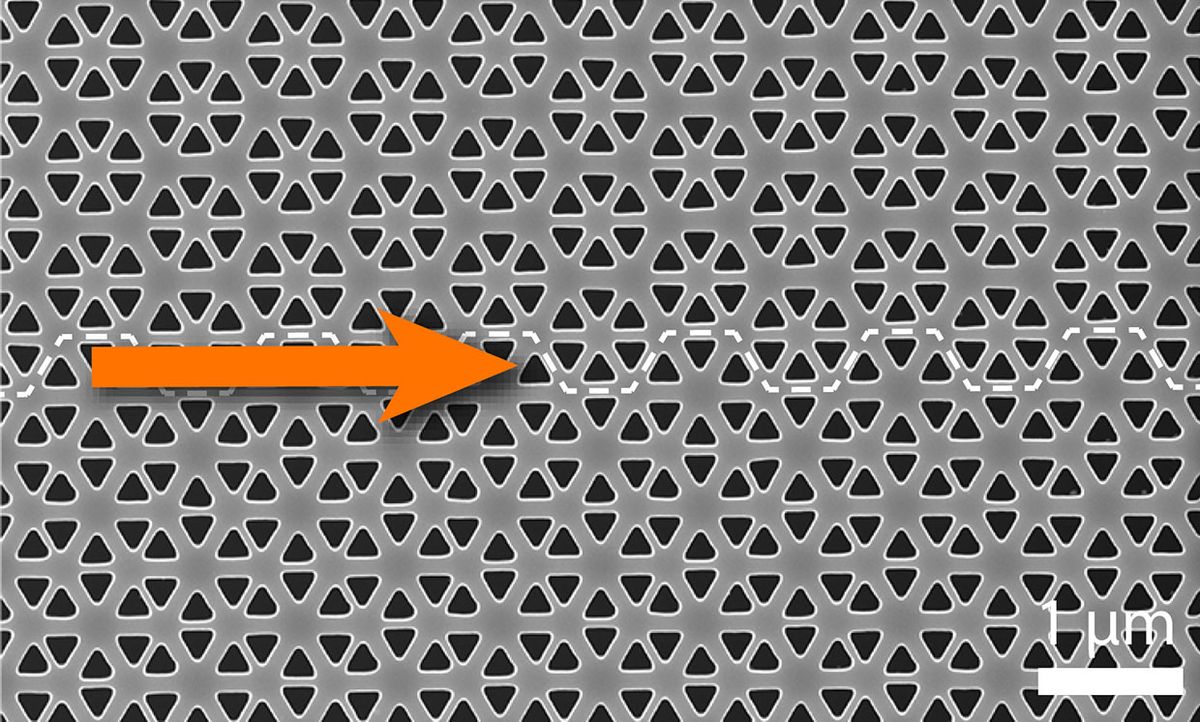In novel materials known as photonic topological insulators, wavelengths of light can flow around sharp corners with virtually no losses. Now scientists have witnessed key details of what the light does inside these structures, which could help them to better engineer these materials for real-world applications.
Topology is the branch of mathematics that explores what features of shapes withstand deformation. For instance, an object shaped like a doughnut can get pushed and pulled into the shape of a mug, with the doughnut's hole forming the hole in the cup's handle, but it could not get deformed into a shape that lacked a hole.
Using insights from topology, researchers developed the first electronic topological insulators in 2007. Electrons traveling along the edges or surfaces of these materials strongly resist any disturbances that might hinder their flow, much as a doughnut might resist any change that would remove its hole.
Recently, scientists have designed photonic topological insulators in which light is similarly "topologically protected." These materials possess regular variations within their structures that lead specific wavelengths of light to flow along their outsides without scattering or losses, even around corners and imperfections.
Previously, researchers had developed a photonic topological insulator capable of directing telecommunications wavelengths around sharp corners with virtually no losses. Scientists achieved this using a so-called photonic crystal, a structure possessing features smaller than the wavelengths of light it is designed to deal with. However, those experiments were essentially looking at a black box—although researchers saw a laser beam go in one side of the photonic crystal and come out the other in a manner that suggested the beam was topologically protected, they could not actually witness the light waves traveling within the photonic crystal, says Ewold Verhagen, an experimental physicist at physics research institute AMOLF in Amsterdam.
In a new study, Verhagen and his colleagues for the first time directly observed topologically protected light waves as they propagated within a photonic crystal. "We thus 'open the box,' taking a peek inside at the peculiar way the light behaves there," he says.
The photonic crystal consisted of a 220-nanometer-thick silicon membrane perforated with 250-nanometer-wide triangular holes. These holes were arranged into clusters where they were either tightly or loosely spaced together. Light entering the photonic crystal flowed topologically protected along the interface between the different sets of holes.
The researchers designed the photonic crystal so that a tiny fraction of the light traveling within it scattered out across its surface. This helped the researchers see that the rest of the light within the photonic crystal did indeed flow around sharp corners without scattering back, demonstrating "the defining advantage of topologically protected light propagation," Verhagen says.
In addition, the scientists found light in the photonic crystal acted much like topologically protected electrons. The strange behavior of electronic topological insulators is rooted in how their electrons' angular momentum or "spin" interacts with their electrons' orbits around atomic nuclei, generating a force resembling a magnetic field that causes their electrons' motions to curve into a circle. In the interior bulk of these materials, the electrons just end up whirling in place, but at the exterior borders of these materials, the electrons do not have enough space to complete a circle, so they instead bounce off the boundaries and end up all flowing in one direction.
The researchers found the polarization of the light in the photonic topological insulator rotated in a specific way, much like the spin of electrons in electronic topological insulators. "This beautifully demonstrates the similarity of the mechanisms that are responsible for topological protection in the case of electrons and photons," Verhagen says. "This shows us how we can use the understanding of electronic systems to design photonic ones that behave similarly."
Previous research had witnessed light traveling within photonic topological insulators with micron-scale features many times larger than a wavelength of visible light. In contrast, this new study witnessed how light behaved in a photonic topological insulator as the light was routed around bends much smaller than a visible wavelength. "This could be a very interesting ability to apply to routing information on photonic chips, for example," Verhagen says.
A number of unexpected discoveries the researchers made suggest topological photonics still has mysteries to unravel. For example, when they let light travel within the photonic crystal toward a four-way junction, "topology dictates that the light shouldn't continue in the forward or backward [direction], but going left and right is both allowed. We expected it to split equally between left and right, but that didn't happen—all of the light chose to turn left," Verhagen says. "To this day, we don't know exactly why it did that, and the fact that these phenomena challenge our intuitions so easily is a large motivation to continue research."
Verhagen, along with Kobus Kuipers at the Delft University of Technology and their colleagues, described their findings in a paper published on 6 March in the journal Science Advances.
Charles Q. Choi is a science reporter who contributes regularly to IEEE Spectrum. He has written for Scientific American, The New York Times, Wired, and Science, among others.



